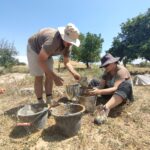The Silk Road is one of the most famous trade routes, which is necessarily associated not only with the exchange of goods and knowledge, but also with cultural customs and cultivated crops. The waypoints on this relatively branched route served as a kind of centers, on whose development it is possible to follow its dynamics. The paper deals with the archaeobotanical research of one such center, in this case the settlement mounds (tepe) in the Ak-Jar locality, situated approx. 20 km east of the city of Osh in southern Kyrgyzstan at an altitude of approx. 1300 m. The locality is located at the foot of the Pamir Mountains, where one of the main branches of the Silk Road left the fertile Ferghana Valley and continued through mountain passes to Kashgar in present-day China.
On the eastern edge of today’s village there are 6 residential hills forming a line approximately 1 km long oriented from southeast to northwest. The diameter of the tepe varies from 70 to 170 m, and their height from less than 10 m to 20 m. Ceramics obtained by surface collection and sounding were classified into the Shurabashat – Markhamat culture phase (4th/3rd century BC – 4th/5th century AD). Radiocarbon data from tepe 2, 4 and 6 refine the dating of these settlement mounds to ca. 100 BC (tepe 6), to the 2nd century AD (tepe 4) and to the 4th-early 5th century (tepe 2). The sounding at tepe 2 and 4 revealed a complex stratigraphy of the destruction of clay architecture, a series of sunken storage pits, and the stratigraphy of the layers of the permanent settlement. This assemblage also served as an environmental archive for the study of the archaeobotanical record.
So far, 139 samples have been analysed, 2023.5 l of sediment were floated and 10,579 mainly charred plant macroresidues were obtained. About 70 taxa of higher plants (about 25 useful ones) were documented. The dominant crop is common barley (Hordeum vulgare) recorded in naked and hulled, two-row and six-row forms. It is the dominant type of cereals of the steppe and mountainous prehistoric sites of Central Asia. The finds also include common and compact forms of naked wheat. The findings of rachis internodes confirmed the presence of two hexaploid species – common wheat (Triticum aestivum) and Indian wheat (Triticum sphaerococcum). Both taxa appear in Central Asia with the beginning of agriculture. Compact forms of cereals are associated with ecologically extreme locations (mountainous and arid). Only marginally, two types of millet-like cereals were recorded – broomcorn millet (Panicum miliaceum) and foxtail millet (Setaria italica). Both crops are native to the northern China region and have been in Kyrgyzstan since the Bronze Age. Two species of legumes were recorded – peas (Pisum sativum) and lentils (Lens esculenta). Legumes are not part of the primary crop package of the first farmers in Central Asia, and have only been spreading since the Younger Bronze Age.
In contrast to the prehistoric localities of Kyrgyzstan, we register numerous documents of cultivated fruit species at the locality we have investigated. The diverse origin of these species is interesting, including probably local taxa – apple tree (Malus sp.), pistachio (Pistacia vera), walnut (Juglans regia); species originating from Western Asia – grapevine (Vitis vinifera), plum tree (Prunus insititia) and species originating from China – peach (Prunus persica). We can observe the spread of most of these species from the end of the agricultural prehistory and in protohistoric times along the Silk Road.
The identified wild plant species indicate synanthropic forestless habitats (field cultures, burial grounds) and steppe or shrub formations (Celtis, Crataegus, Eleagnus, Juniperus, Pistacia, Prunus, Rubus, Sorbus). The dominant weed vegetation is Tausch’s goatgrass (Aegilops tauschii). Wetland and steppe species have also been recorded.
Archaeobotanical analysis has confirmed that living conditions on the Silk Road between about 100 BC and 400 AD were very friendly. Compared to today, we expect a greater diversity of habitats in the landscape (e.g. springs, wet ravines, shrublands or floodplains of woody plants, but also synanthropic habitats). Whether the current state is the result of climate change (aridization) or, for example, changes in management associated with excessive grazing caused in the vicinity of the site by the transition to a sedentary lifestyle is a question for further research.


